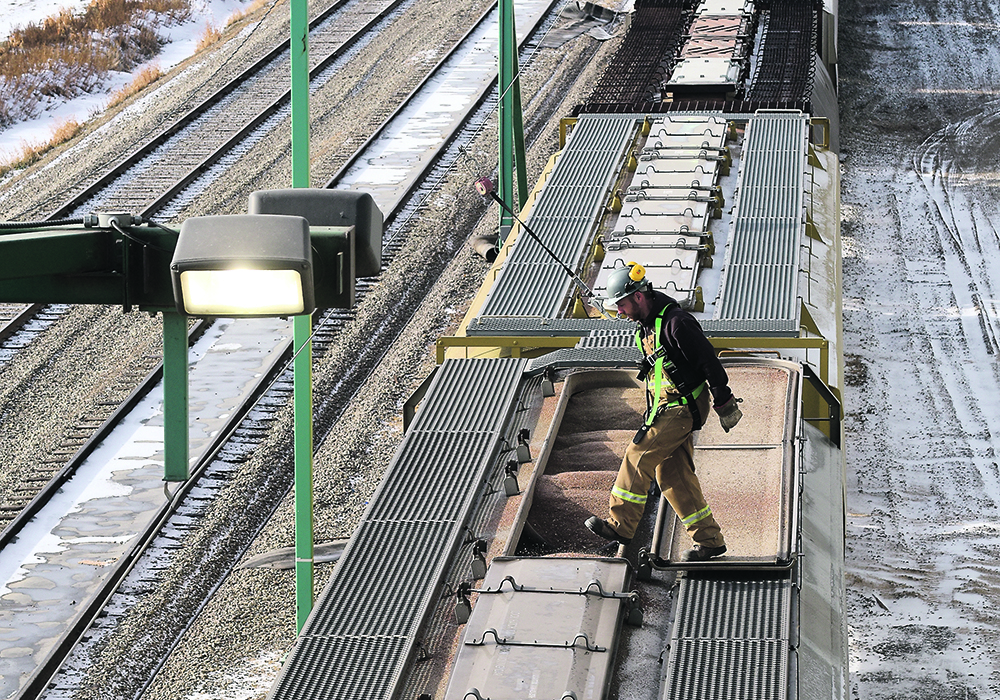One consequence is an imbalance between grain stocks in country elevators and stocks at west coast export terminals
Frigid temperatures in February have thrown a speedbump in front of what has otherwise been an exceptional year for bulk grain movement.
Canada’s bulk supply chain is still feeling the effects of a two- to three-week cold snap in February that slowed rail traffic, disrupted export sales programs and pushed grain inventories in the country elevator system to uncomfortably tight levels, said observers who spoke to The Western Producer last week.
The system is recovering, they added. And overall, railway companies are still on track to move record amounts of Canadian grain this year to export position.
Read Also

Farming Smarter receives financial boost from Alberta government for potato research
Farming Smarter near Lethbridge got a boost to its research equipment, thanks to the Alberta government’s increase in funding for research associations.
But stress points are evident.
Mark Hemmes, president of Quorum Corp., said one lingering symptom from last month’s cold snap is an imbalance between grain stocks in country elevators and stocks at west coast export terminals.
As of early March, grain inventories in country elevators occupied 88 percent of working capacity, according to the Grain Monitoring Program’s most recent supply chain report.
Those numbers haven’t caused a significant concern yet, in terms of affecting producer deliveries. But they’re higher than the industry would like to see.
“I think when it’s below 85 percent, things are running pretty good,” Hemmes said.
“When it goes over 90 percent, that’s when we start to hear from people in the country locations, as elevators start turning deliveries away, or doing it through basis.”
Wade Sobkowich, executive director of the Western Grain Elevators Association, which represents Canada’s major grain handling companies, said inventory levels are currently tight.
“That is the result of farmers continuing to deliver but the railways not meeting as high of a percentage of week-to-week (rail car) demand as we had expected.”
According to data from the Ag Transport Coalition, car order fulfilment slipped in early February and has struggled to recover.
During the last three weeks of the month, Canadian National Railway fulfilled, on average, about 53 percent of its rail car orders.
Canadian Pacific Railway’s average weekly fulfillment over the same period was about 70 percent.
At the height of the cold snap, in Crop Week 28, car order fulfillments dropped to 31 percent at CN and 60 percent at CP, the ATC said.
“We did have a cold snap so that’s part of the reason, but it’s important to note that for whatever reason, rail capacity on a week-to-week basis has been falling short of demand,” Sobkowich said.
WGEA grain handlers “have been accepting producer deliveries to the extent that there is elevator space but we’re not shipping out at the same rate that we’re receiving, so we need those car order fulfilment percentages to increase in the very near term.”
Hemmes said country deliveries, fueled by high grain demand and strong commodity prices, have been running consistently high for the past few months.
Producer deliveries that were averaging above 1.2 million tonnes per week before the February cold snap dropped to around 650,000 tonnes in the week ending Feb. 14.
Since then, producer deliveries have rebounded quickly but rail movements and car order fulfillment have been slower to respond.
Greg Northey, vice-president of industry relations with Pulse Canada, said the industry has been generally satisfied with railway performance but the slow recovery in the last half of February and the first half of March has been frustrating.
As of early March, ATC shippers that rely on CN for rail service had unfulfilled demand for 6,000 hopper cars, he said.
“It’s been rough,” said Northey.
“We just haven’t seen the capacity that we’ve needed.”
“Generally it’s been a fairly decent year but… the last three weeks have really showed the unpredictability of rail performance and the kind of impact that it can have on shippers.
“A lot of it comes out of the cold weather but some of it we can’t quite put our finger on why that capacity isn’t there, especially in the past three weeks.”
Railways are working to reduce built-up inventories in the country but it will take time to draw down supplies, Hemmes added.
“Railways don’t turn on a dime,” he said.
“(It takes them) a few weeks to recover and get their cycles back into sync and the flows back to normal, so I think that’s why we’re seeing this really stark imbalance between the country and the ports right now, although I’m pretty confident that it’ll level itself out.”
There have been other supply chain issues, he added.
Vessel lineups on the West Coast have been at uncomfortably high levels for months and are expected to rise further in the coming weeks.
As of last week, there were 28 bulk ocean freighters waiting to be loaded at the Port of Vancouver and seven at Prince Rupert.
Another 11 ships were expected to arrive in Vancouver by March 17 and three more were scheduled to arrive at Prince Rupert.
Ideally, the number of waiting vessels in Vancouver is about 20, according to industry sources. Two or three is deemed acceptable for Prince Rupert.
Hemmes said the vessel lineup built up during August and September and never recovered.
He said the railways are working to keep volumes up, but a lot of grain is arriving not in the sequence with vessels that are showing up.
“When the grain doesn’t arrive in the sequence that the vessels have arrived… it can really start to ball up the system a bit.”
Sobkowich said overall, the grain industry is pleased with the higher volumes being put through the system.
“However, I would also point out that there have been supply chain execution issues in spite of the fact that overall numbers are up.”
Ocean freight rates have also been increasing during the past few months, raising the prospects of increased demurrage costs for bulk shippers.
The Baltic Dry Index, a measure of ocean freight rates for various sizes of ocean vessels, has nearly tripled over the past 12 months and the daily rate for a Pacific Panamax-sized vessel jumped above $21,000 last week.
The average daily rate for a Panamax in 2020 was around $9,000.
Although most of the ships currently anchored at the West Coast were booked three to four months ago at a lower cost, demurrage costs and contract penalties are a growing concern.
Overall, the Canadian supply chain has performed very well through the last 12 months, Hemmes said.
In Vancouver, terminal exports at the end of February were listed at 18.5 million tonnes, up 42 percent from last year.
According to statistics from the Canadian Grain Commission, total exports of all Canadian grain, oilseeds and pulse crops through the first 31 weeks of the 2020-21 crop year were listed at 33 million tonnes, up from 24.6 million last year.


















